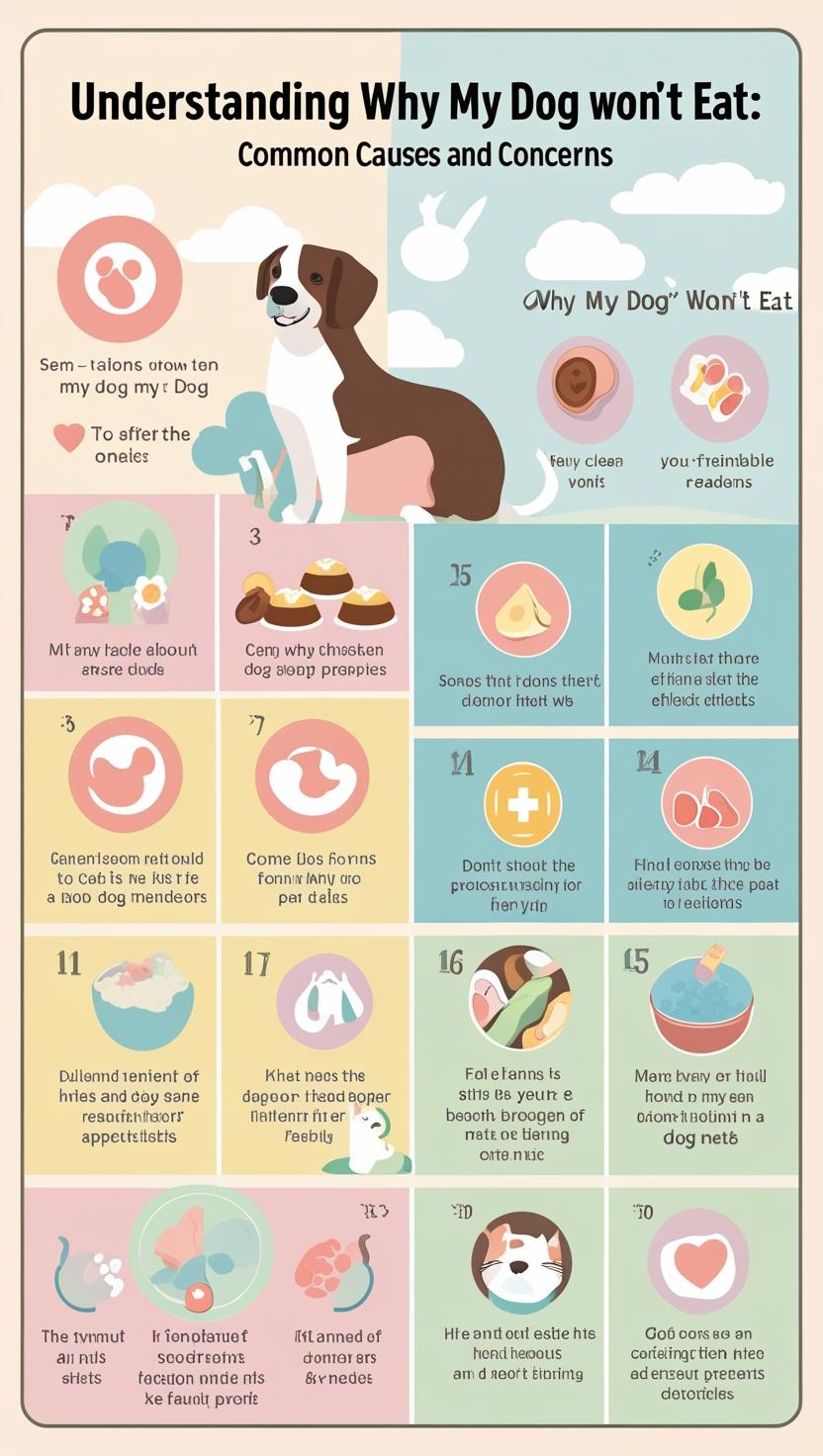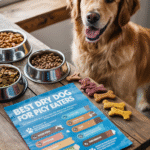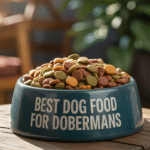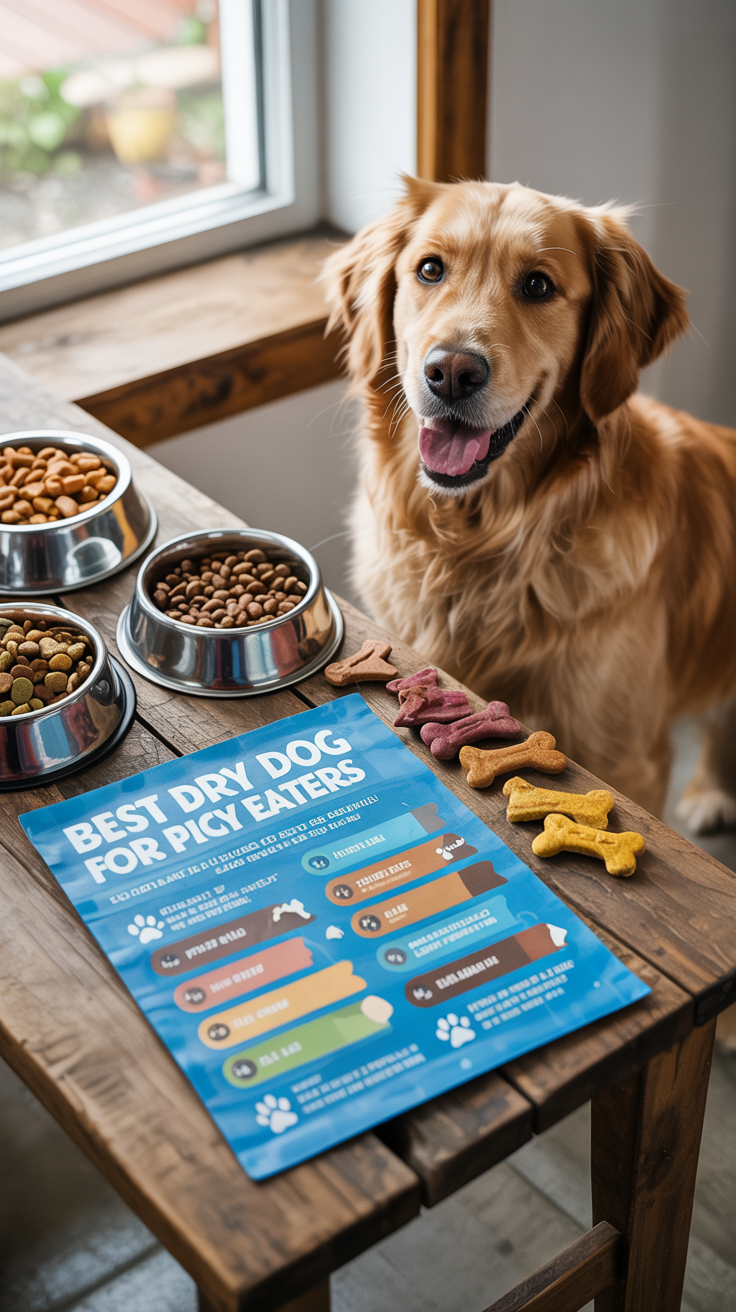As a loving dog owner, it can be distressing when your furry friend turns their nose up at food. Understanding why my dog won’t eat involves examining several factors. These can range from health issues to environmental influences. By identifying the cause, you can help your canine companion regain their appetite.
Several common reasons can lead to loss of appetite in dogs. Recognizing these can help you take the right steps to encourage healthy eating habits.
Medical Issues
One of the primary concerns when your dog refuses to eat is health-related. Various medical conditions can impact a dog’s appetite:
- Dental Problems: Dogs suffering from dental issues may find it painful to chew. Check for signs like bad breath, swollen gums, or difficulty eating.
- Gastrointestinal Issues: Vomiting, diarrhea, and other digestive problems can lead to nausea, making your dog hesitant to eat.
- Infections: Bacterial or viral infections can lead to a loss of appetite. Consult your vet if you observe lethargy or other unusual signs.
- Chronic Diseases: Conditions such as kidney disease or diabetes can dramatically affect appetite. If your dog has a chronic illness, regular vet check-ups are essential.
Changes in Environment
Dogs are creatures of habit and can be sensitive to changes in their surroundings. Alterations that may impact their eating habits include:
- New Home: Moving to a new environment can be stressful for dogs, leading to anxiety about food.
- Change in Routine: Adjusting their daily schedule, such as feeding times or exercise, might affect their appetite.
- New Family Members: The introduction of new pets or even people can disrupt a dog’s normal behavior.
- Lack of Comfort: If your dog’s feeding area is loud or chaotic, they may feel uncomfortable eating.
Picky Eating Habits
Some dogs can be notoriously picky. Factors contributing to this behavior may include:
- Type of Food: If you frequently change your dog’s food or give table scraps, they may develop preferences.
- Stale Food: Always ensure that the food is fresh and has not expired, as dogs won’t eat something they find unappealing.
- Food Allergies: Allergic reactions to certain ingredients can cause your dog to avoid their meals. Monitor any signs of discomfort.
Emotional Issues
Just like humans, dogs can experience emotional stress. Some triggers may include:
- Separation Anxiety: If your dog feels anxious when you leave, it can affect their eating.
- Fear or Trauma: Past traumatic experiences can lead to food aversion.
- Depression: An unhappy dog may lose interest in food. Changes in behavior, such as lethargy, could be indicative of this.
When facing the challenge of a dog not eating, the first step should always involve consulting with your veterinarian. They can rule out serious health concerns and recommend potential solutions based on your dog’s specific needs. Visit AKC for more insights into dog health.
Tips to Encourage Healthy Eating
While you wait for your vet appointment or if your dog’s situation isn’t serious, consider trying these strategies to encourage your dog to eat:
- Stick to a Schedule: Regular feeding times can help establish a routine, making your dog more likely to eat at those times.
- Mix with Favorites: Introduce a little of your dog’s favorite treats or wet food to their regular diet to entice them.
- Reduce Stress: Create a calm feeding environment where your dog can eat in peace.
- Exercise: Increasing your dog’s physical activity can foster a stronger appetite.
Keep an eye on your dog’s health and eating habits. If your dog’s reluctance to eat persists for more than a day or two, it is vital to reach out to your veterinarian. For further reading on canine nutrition, check out PetMD. Remember, a healthy dog is a happy dog!
The Importance of a Balanced Diet for Dogs
A balanced diet is essential for dogs to thrive and maintain good health. Dogs, much like humans, require a proper mix of nutrients to support their bodily functions. When we talk about a dog’s diet, we are usually referring to a combination of proteins, carbohydrates, fats, vitamins, and minerals. Each of these components plays a crucial role in ensuring that your dog lives a long, healthy, and happy life.
Protein is one of the building blocks of a dog’s diet. It supports growth, repair, and maintenance of tissues. Dogs require high-quality protein sources to fuel their energy levels. Common sources include:
- Chicken
- Beef
- Fish
- Eggs
In addition to protein, carbohydrates are necessary for providing energy. They also help in the proper functioning of the digestive system. Opt for healthy sources like:
- Brown rice
- Oats
- Sweet potatoes
- Fruits and vegetables
Fats are also important in a dog’s diet. They provide energy, aid in the absorption of certain vitamins, and support skin and coat health. Look for healthy fat sources, such as:
- Fish oil
- Flaxseed oil
- Poultry fat
Vitamins and minerals are equally significant. They help in various metabolic processes and are vital for overall health. A balanced diet can provide the necessary vitamins and minerals, but supplementation may be required in certain cases. Important ones include:
- Vitamin A for vision and immune function
- Vitamin D for bone health
- Calcium for strong teeth and bones
- Iron for blood health
Feeding your dog a well-rounded diet helps to prevent health problems. Without the right nutrients, dogs may suffer from fatigue, poor coat conditions, and digestive irregularities. Over time, an unbalanced diet might lead to chronic issues such as obesity, diabetes, or heart disease.
It is also important to consider age, weight, and activity level when determining your dog’s nutritional needs. Puppies, adult dogs, and senior dogs all require different nutrient balances. For instance, puppies need more protein and fat to support their rapid growth, while older dogs may benefit from lower-calorie options to maintain a healthy weight.
Transitioning your dog to a new diet should be done gradually. Start by mixing a small amount of the new food with the old food, gradually increasing the ratio of the new food over a week. Sudden changes can lead to digestive upset.
Always consult with your veterinarian before making any significant changes to your dog’s diet. They can provide personalized recommendations based on your dog’s specific needs and health status.
| Age Group | Dietary Needs | Recommended Portions |
|---|---|---|
| Puppy | Higher protein and fat | 4 meals a day |
| Adult | Balanced diet | 2 meals a day |
| Senior | Lower fat, controlled calories | 2 tailored meals a day |
Purchasing high-quality dog food is another essential step in ensuring a balanced diet. Look for brands that meet industry standards and guidelines set by organizations such as the Association of American Feed Control Officials (AAFCO). Reading labels and understanding ingredient lists helps you select the best option for your dog.
Regular monitoring of your dog’s weight and health can ensure they remain healthy and energetic. An appropriate diet can significantly impact their quality of life.
Remember, a well-nourished dog is a happy dog. Make informed choices about their nutrition, and consult various resources to stay updated. For further insight into canine nutrition, visit Veterinary Partner or PetMD. These platforms offer valuable information and articles about maintaining your dog’s health through balanced nutrition.
Behavior Changes in Dogs and Their Link to Eating Habits
Changes in a dog’s behavior can often be linked to their eating habits. If your four-legged friend suddenly loses interest in food, it’s essential to look at various factors that could be influencing this change. Understanding these connections can help you identify underlying issues and ensure your dog remains healthy and happy.
When a dog refuses to eat, it can signal more than just a picky palate or a food preference. Several behavioral changes may also signify health concerns, stress, or emotional distress. Being attuned to your dog’s behavior provides clues to their overall wellbeing.
Common Reasons for Changes in Eating Habits
- Health Issues: A variety of health problems can lead to a decrease in appetite. These include dental issues, gastrointestinal problems, or infections.
- Stress and Anxiety: Environmental changes such as moving to a new home, the arrival of a new pet, or family changes can cause stress and affect eating habits.
- Dietary Changes: Switching food brands or types, or even not giving your dog their favorite food can lead to reluctance to eat.
If you notice your dog acting differently, make a note of these changes. A dog who typically races to their bowl may be disinterested one day. Observing other behaviors like lethargy, excessive barking, or hiding can help assess the situation better.
Health Concerns to Explore
Here are several health issues that can cause dogs to lose their appetite:
- Nausea: Dogs will often refuse food if they feel nauseous. This can stem from eating something toxic, eating too much, or underlying health issues.
- Dental Pain: If your dog has a dental problem, such as a broken tooth or gum disease, they may avoid food because it hurts to eat.
- Infection: Bacterial, viral, or parasitic infections can lead to a loss of appetite. Symptoms like vomiting or diarrhea often accompany such illnesses.
If your dog’s behavioral change persists over a few days, consulting the veterinarian is crucial. They can provide a thorough examination and recommend further tests if necessary.
Behavioral Triggers
Aside from health issues, behavioral triggers can significantly affect your dog’s eating habits. These may include:
| Behavioral Trigger | Impact on Eating |
|---|---|
| Changes in routine | Dogs thrive on routine, and changes can lead to anxiety and loss of appetite. |
| New environments | Moving or visiting new places can stress dogs, causing them to reject food. |
| Family stress | High-stress household dynamics can impact your dog emotionally, leading to decreased appetite. |
It’s important to create a calm and stable environment for your dog. Providing a consistent routine feeds into their sense of security. Ensure they have a quiet, comfortable space where they can eat without distractions.
Evaluating Your Dog’s Weight
Monitoring your dog’s weight is essential. Sudden weight loss can indicate a serious health issue needing immediate attention. Keep track of their body condition score (BCS) to ensure they remain in a healthy weight range. This allows you to adjust feeding practices or consult a veterinarian if necessary.
Effective Strategies to Encourage Eating
If you find yourself saying, “my dog won’t eat,” here are some strategies to encourage them:
- Stick to a feeding schedule, presenting meals at the same time each day.
- Offer tasty, high-quality dog food that your pet loves.
- Add broth or wet food to dry kibble to make it more enticing.
- Limit treats between meals, so your dog feels more inclined to eat their food.
It is crucial to approach this issue with patience. If behavioral changes persist or worsen, seeking advice from your veterinarian is always the best course of action. For more information about dog behavior, nutrition, and health, check resources like The American Kennel Club or visit ASPCA for valuable insights and resources.
When to Consult a Veterinarian About Your Dog’s Eating Issues
It can be quite distressing when you notice that your dog won’t eat. This change in behavior may indicate various issues, and understanding when it’s time to consult a veterinarian is crucial for your furry friend’s health.
First, it’s essential to identify how long your dog has been refusing to eat. If your dog skips a meal once or twice, it may not be a cause for concern. However, if your dog continues to refuse food for more than 24 hours, it is advisable to seek professional advice. Persistent refusal to eat can lead to severe health problems, including malnutrition.
Signs Your Dog Needs Immediate Attention
Several signs indicate that you should consult a veterinarian. Look out for the following:
- Vomiting or Diarrhea: If these symptoms accompany your dog’s refusal to eat, it could indicate gastrointestinal problems.
- Lethargy: If your dog seems unusually tired or inactive, it may signify an underlying health issue.
- Excessive Thirst: Increased water consumption, especially alongside a lack of appetite, can indicate diabetes or kidney problems.
- Pain Behavior: If your dog whines, whimpers, or shows signs of discomfort when eating or moving, they might be in pain.
- Weight Loss: Noticeable weight loss over a short period is a serious matter that needs immediate attention.
Duration of Eating Issues
The length of time that your dog has been refusing food is crucial. Here’s a quick guide:
| Time Frame | Action Needed |
|---|---|
| 1 meal skipped | Monitor behavior and consider offering a small treat. |
| 24 hours without food | Contact your veterinarian for advice. |
| More than 48 hours | Seek veterinary care immediately. |
Possible Causes for Loss of Appetite
Understanding what might be causing your dog’s eating issues can help you articulate the situation better to your veterinarian. Common causes include:
- Dental Issues: Gum disease or tooth pain can make chewing uncomfortable.
- Dietary Preferences: Dogs can be picky eaters. Changes in their food or tiredness of their usual meals can make them refuse to eat.
- Illness: Conditions ranging from minor infections to severe illnesses can lead to a decreased appetite.
- Medications: Some medications can influence your dog’s hunger.
When to Seek Emergency Care
In certain situations, it’s vital to seek emergency care. If your dog exhibits any of the following symptoms, do not hesitate to contact a veterinary clinic:
- Severe abdominal bloating or pain
- Excessive or debilitating vomiting
- Unconsciousness or severe disorientation
- Unexplained bleeding
As a pet owner, you know your dog best. If something feels off, trust your instincts and seek help. Your veterinarian is your best resource for diagnosing and treating your pet’s eating issues.
Being proactive about your dog’s health can make a significant difference. Identifying the signs early and understanding when to consult a veterinarian will ensure your friend stays happy and healthy.
For more detailed information on dog health and nutrition, consider visiting the American Kennel Club or Vetstreet. These resources provide valuable insights into maintaining your dog’s well-being and dealing with common issues like eating problems.
Tips to Encourage Your Dog to Eat Again
Seeing your dog refuse to eat can be concerning for any pet owner. If your dog won’t eat, it’s essential to approach the situation with patience and understanding. There are various reasons your four-legged friend might lose their appetite, ranging from health issues to stress or simply pickiness about food. Here are some effective tips that can encourage your dog to eat again.
Assess the Food
First, evaluate the type and quality of the food you are providing. Sometimes, your dog may not eat because they do not find the food appealing. Consider these steps:
- Check the expiration date on the dog food.
- Switch protein sources, such as moving from chicken to beef.
- Try mixing dry kibble with wet food for added flavor.
- Warm the food slightly to enhance the aroma.
Consider a Feeding Schedule
Just like humans, dogs can benefit from having a routine. Establishing a regular feeding time can make mealtime more predictable and encourage eating. Here’s how you can implement a feeding schedule:
- Offer food at the same times each day.
- Limit access to food outside of mealtime to avoid constant grazing.
- Give your dog 15 to 30 minutes to eat, then remove the food until the next meal.
Examine Environmental Factors
Your dog’s eating habits can be affected by their environment. Make sure the eating area is calm and comfortable. Here are some tips:
- Keep the space quiet and free from distractions.
- Avoid putting the food bowl near loud items, such as vacuums or washing machines.
- Provide a cozy spot for your dog, away from other pets.
Check for Health Issues
If your dog continues to refuse food for more than a couple of days, it may be time to consult a veterinarian. Various health issues could cause a lack of appetite, such as:
- Dental problems
- Gastrointestinal issues
- Infections or illnesses
- Medications that reduce appetite
Always prioritize your dog’s health, as a prolonged lack of eating can lead to more severe health consequences.
Introduce New Tastes
Sometimes, your dog may just be bored with their usual food. To rekindle their interest, consider introducing new flavors and textures:
- Mix in some plain, cooked chicken or turkey.
- Add small amounts of pumpkin or sweet potatoes.
- Offer a little bit of low-sodium chicken or beef broth.
- Try flavored dog treats to see if they spark your dog’s interest.
Use Positive Reinforcement
Encouraging your dog to eat can also be a matter of motivation. Use positive reinforcement to create a more enjoyable mealtime experience:
- Praise your dog when they start to eat.
- Give small rewards when they finish their food.
- Ensure they associate mealtime with positive experiences.
Using these strategies can create a more appealing environment for your dog during mealtime.
Consult Pet Nutritional Guidelines
If you’re unsure about what to feed your dog, consider consulting pet nutritional resources. Websites like PetMD or AKC offer great information on dog nutrition and meal ideas that may help.
Be Patient
Ultimately, patience is key when encouraging your dog to eat again. Sometimes, dogs may take time to adjust to changes in diet or circumstance. Monitor their behavior and maintain consistency in feeding practices.
If your dog’s eating habits don’t improve after trying these suggestions, please reach out to a veterinarian. Remember, your dog’s health and happiness should always come first. By taking these steps, you can help encourage your dog to eat once more.
Conclusion
Dealing with a dog that won’t eat can be a concerning situation for any pet owner. Understanding the root causes behind your dog’s lack of appetite is the first step toward finding a solution. Whether it’s due to a health issue, an unbalanced diet, or behavioral changes, recognizing these factors can help you take appropriate action.
A well-balanced diet is crucial for your dog’s overall health, and any dietary changes should be introduced gradually to avoid further issues. If your dog is exhibiting behavioral changes alongside their eating habits, it’s essential to consider the potential underlying emotional or physical triggers.
When your dog refuses to eat for an extended period, it’s wise to consult a veterinarian. They can help identify any medical problems that may require treatment. Remember, timely intervention can make a significant difference in your dog’s health and well-being.
To encourage your furry friend to eat again, try offering enticing food options or changing their feeding routine. Simple strategies such as warming up their meals or using puzzle feeders can stimulate their interest.
Your dog’s health is intertwined with their nutrition and well-being. By being proactive in understanding their needs and behaviors, you’ll not only help them regain their appetite but also strengthen the bond you share. Keep a close eye on your dog’s eating habits and continue to adapt your approach to ensure they are happy and healthy.
















Leave a Reply